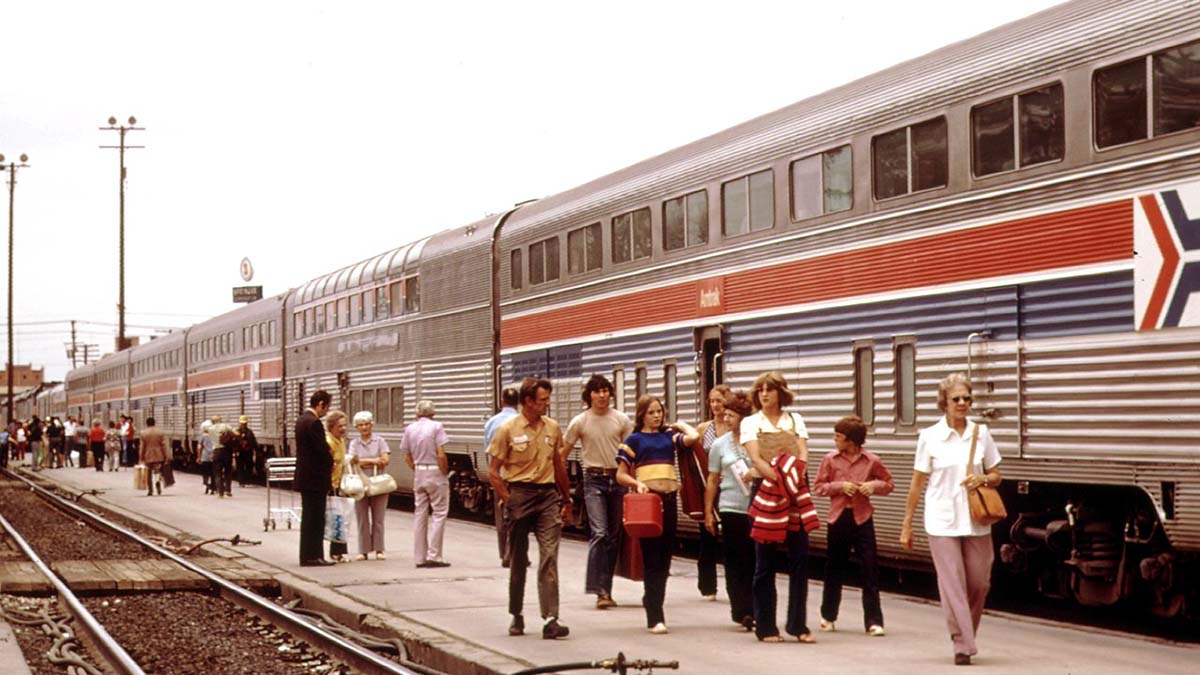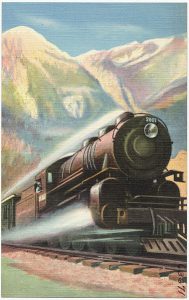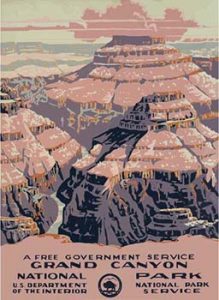
by Robert Hale
This is an interesting anniversary year. The US National Park Idea (America’s Best Idea) is 140 years old; Amtrak is 40 years old. They are connected!
Let’s go back to the summer of 1957 for a snippet of a conversation: “If it weren’t for the railroads you and I might be selling newspapers. Take a long look at that down there.”
That’s Jack, my boss at the Great Northern Railroad desk in Glacier Park Lodge. A summer passenger agent – me, holding down a three-month long job – is listening intently to a man who knows the story.
Slowly rolling past the Glacier Park east entrance is the Empire Builder, with its sparkling new Great Domes. The Builder doesn’t stop at the park. That’s the duty of its sister train, the Western Star. The Star is an equally sleek streamliner (but without the domes) that runs between Chicago, and Seattle and Portland.
Jack’s not smiling. “Take a long look. You’ll never see another new car on the Great Northern, or any other line. That’s the end of it. We might be selling newspapers yet!”
 It all began when the Northern Pacific slammed down the last spike in 1882 and its trains started chugging passengers to Yellowstone. That event got the nation looking at itself – in person, first hand!
It all began when the Northern Pacific slammed down the last spike in 1882 and its trains started chugging passengers to Yellowstone. That event got the nation looking at itself – in person, first hand!
Early train travel was expensive. It was much like riding Amtrak today – beyond the budget of most Americans! But, that fit the plans of the railroads. The railroads knew that the more the wealthy rode, the quicker the fares could come down bringing more Americans to the rails. And to make sure that happened, the Northern Pacific went on an advertising campaign unlike anything seen before in the US and Europe. Magazine ads, newspaper ads, billboards and flyers – there wasn’t an advertising outlet the Northern Pacific missed. The NP could take travelers west to the parks and to the ocean.
The Northern Pacific saw potential profit from the vastness and emptiness of the Yellowstone area. To that end it not only promoted the geysers through advertising and word-of-mouth, it used every bit of political pressure it could muster to have the area declared a “national park.”
It is that “pressure” and the tactics employed by the railroad that moved Yellowstone’s late historian, Aubrey L. Haines, to excoriate the railroad. Heavy-handed, cajoling, threatening, exploiters, bad guys, devious, sly, cunning, Haines says of the NP.
But, one has to ask: “If not the railroad, then who?”
Haines then attacks the Northern Pacific for, “…the mundane purpose of making a profit, in this case by hauling tourists…” A profit…by hauling tourists. Hauling tourists, why the very thought of it…a really bad idea…almost evil! Mundane, indeed…But, a question: “If not a profit, than for what?”
There is one more evil characteristic of the railroad according to Haines: Monopoly! That’s been the operative word since the beginning of the railroads and the national parks. Hotels, buses, and service stations are each operated as a monopoly within the national parks…by law!
Make no mistake here; the Northern Pacific was in it all the way to make a profit – an idea that rankled historian Haines no end. What the motive of the railroad should have been he did not say.
For certain, along the way the NP manipulated, pressured, and buttonholed to get it’s way – and right-of-way – in Yellowstone. Business was, for good or evil, being conducted the way business was conducted in the 19th and early 20th centuries.
The NP invited artist Thomas Moran to visit the area and to help promote it as a tourist destination. Moran’s paintings of the falls marked the “beginning of the beginning” for America’s National Parks.
The Northern Pacific’s exploration and development of Yellowstone moved other railroads to “sell” the vistas and wild spectacles along their rights-of-way. The Southern Pacific pushed hard for the establishment of Yosemite, Sequoia, and General Grant National Parks. General Grant was eventually absorbed into Kings Canyon National Park.
 The Santa Fe railroad went “All the Way” to the Grand Canyon, where it built a luxury hotel and resort complex. The Union Pacific established itself on the opposite side of the canyon. The park facilities are still bringing in visitors by the thousands.
The Santa Fe railroad went “All the Way” to the Grand Canyon, where it built a luxury hotel and resort complex. The Union Pacific established itself on the opposite side of the canyon. The park facilities are still bringing in visitors by the thousands.
Eventually, Santa Fe, Union Pacific, Southern Pacific, Northern Pacific, Great Northern, Burlington, Milwaukee Road, Chicago and Northwestern, all had stops adjacent to, or relatively near various national parks.
In contrast to almost every other rail line, the Great Northern bought its own roadbed, not relying on federal government arrangements, as it laid down track to the west coast. In addition to hotels – in two countries, one must add – the Great Northern added several chalets along high mountain trails in Glacier Park to accommodate over-night hikers. Great Northern’s Western Star made two “front door” stops in Glacier National Park– East Glacier, and Belton on the western edge.
Taking a train to the national parks today is obviously not what it once was. Amtrak’s Empire Builder still makes the two Glacier Park stops. Amtrak will get you to Merced, California and then an Amtrak bus will transport you to Yosemite Valley. Amtrak’s Southwest Chief, a descendant of Santa Fe’s famous Chief and Super Chief trains, arrives in Williams, AZ where visitors can board the Grand Canyon Railway’s spiffy, shiny, and sleek service right to the rim! The latter is a daily excursion train – a delightful experience on a highly spruced up train. And that’s about it for train rides to the Parks!
So, while the famous delightful over-night experiences of comfy beds and pillows, expertly prepared meals, and the perfect pace for traveling are available on precious few Amtrak trains, the National Parks are still there, beckoning with their ageless wonders. And, if you plan it correctly, you can still fall asleep to the rhythm of the rails. So, Happy birthday National Park Service; Happy birthday Amtrak!
(Oh…and those newspapers Jack thought we might be selling… they’re in not doing so well either!)
If You Go:
Amtrak Train Travel Info: www.seat61.com/UnitedStates.htm
About the author:
Freelance writer, Bob Hale is a former Chicago radio and TV broadcaster. His college summers were spent in the passenger departments the Burlington Railroad in Chicago, and the Great Northern in Glacier National Park.
Photo credits:
Amtrak train and passengers by: National Archives at College Park / Public domain
Northern Pacific Montana poster illustration: Boston Public Library / Public domain




Leave a Reply
You must be logged in to post a comment.